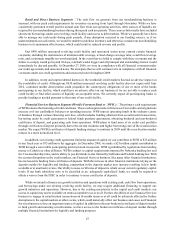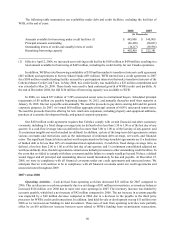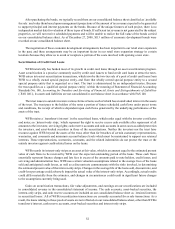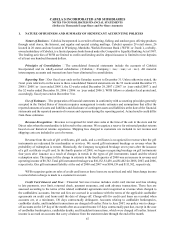Cabela's 2008 Annual Report Download - page 62
Download and view the complete annual report
Please find page 62 of the 2008 Cabela's annual report below. You can navigate through the pages in the report by either clicking on the pages listed below, or by using the keyword search tool below to find specific information within the annual report.57
Economic Development Bonds
We recognize economic development bond investments based on estimates of the discounted future cash
payments to be received under these bonds. These estimates are also the basis for our recognition of deferred grant
revenue to be received under the economic development grants as an offset to construction costs which is amortized
over the asset lives of the development. These cash flow estimates are dependent on property and/or sales tax
collections derived from our operations, and potentially other businesses, some of which may be in the development
stage. Had our fair value estimates been lower by 10% as of the end of 2008, the value of economic development
bonds reflected in our consolidated financial statements would have been approximately $11 million less with the
unrealized loss reflected in comprehensive income (loss) if the loss was deemed to be temporary. Any declines in the
fair value of held-to-maturity and available-for-sale economic development bonds below cost that are deemed to be
other than temporary are reflected in earnings as realized losses. Gains and losses on sales are recorded on the trade
date and determined using the specific identification method.
Asset Securitization
WFB securitizes the majority of its credit card loans, and recognizes gains or losses on the sales, as well as
records certain retained interests, including transferor’s interest, interest only strips, cash reserve accounts, cash
accounts, and asset-backed securities, which are all subject to significant valuation assumptions. The interests in
securitized receivables, including the transferor’s interest, interest only strips, cash reserve accounts, cash accounts
and asset-backed securities, are reported at fair value or cost in the consolidated balance sheets. Certain estimates
used in the determinations of gains on sales, and the related fair values of the asset accounts, are influenced by
factors outside of our control, and as a result, such estimates could materially change in the near term. On a quarterly
basis, we review and adjust, as appropriate, the assumptions and estimates used in determining the fair value of
the related accounts recognized in connection with these securitization transactions. If these assumptions change,
or actual results differ from projected results, asset balances and securitization income would be affected. If we
had made different assumptions for the periods covered by the consolidated financial statements, WFB’s financial
position and results of operations could have differed materially.
Certain of these assumptions and estimates will change in the future with changes in market and economic
conditions. For example, rates paid to investors, as well as projected interest income, are primarily variable rates
which change with market interest rate changes, and loan payment rates could fluctuate based on general economic
conditions. Changes in these factors may result in future estimates of the excess spread and payment rates being
materially different from the estimates used in 2008. Refer to Note 4 for the sensitivity analysis of the current fair
value of retained interests and the impact on fair value from an immediate adverse change of 10% and 20% in the key
economic assumptions used to determine fair value.
Recent Accounting Standards and Pronouncements
As of December 30, 2007, FAS No. 159, The Fair Value Option for Financial Assets and Financial Liabilities-
Including an Amendment to FASB Statement No. 115 became effective for the Company. This statement permits
entities to choose to measure many financial instruments and certain other items at fair value on an instrument by
instrument basis with changes in fair value reported in earnings. The Company has elected not to adopt the fair value
option under FAS No. 159 on any financial instruments or other items held.
Effective December 30, 2007, we adopted the provisions of FAS No. 157, Fair Value Measurements. This
statement defines fair value, establishes a hierarchal disclosure framework for measuring fair value, and requires
expanded disclosures about fair value measurements. The provisions of FAS 157 apply to all financial instruments
that are being measured and reported on a fair value basis. In addition, in February 2008, the FASB issued FASB
Staff Position (“FSP”) FAS 157-2, Effective Date of FASB Statement No. 157. This FSP delays the effective date
of FAS 157 to fiscal years beginning after November 15, 2008, and interim periods within those fiscal years for
all nonfinancial assets and liabilities, except those that are recognized or disclosed at fair value in the financial
























